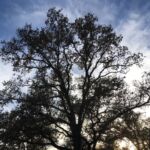
Spring officially arrived this week.
Outside, anyway. The daffodils and hyacinths are blooming in my front yard, but it is still winter inside me.
I was hoping that I would have gotten over this by now. I first wrote about not feeling very spring-like a few weeks ago. It would have been nice if the official arrival of spring flipped me right into a brighter mood, like it came with an automatic easy switch.
It’s just going to take a little more time.
One of my dear friends is very ill. Still. And other parts of my life that have been stable for decades are shifting, and I’m not sure how it’s all going to work out.
I had a fortunate encounter this week, though, with one of my good neighbors. I often run into her and her three dogs while walking around town. It always makes my day (and Biscuit’s day, too, since one of her dogs is one of his best friends). She had just returned from an in-service where she learned about Gestalt Therapy and shared some things that were helpful. I’m not quoting her exactly (or at all), and I might be remembering parts of our conversation wrong, but this is what I took away:
If you think about your life as a river, then for many of us, much of the time, it flows along, generally calmly. Not too rocky. Not too rough. But then! There are times when things fall apart. Someone dies, or a relationship ends, or somebody moves or gets sick, or kids grow up and head out to live their own wonderful lives, or you get fired, or management changes, or your insurance company decides not to offer you fire insurance anymore (this is maybe more of a minor thing, but it’s something that I just realized I could start worrying about after State Farm announced this week that they are going to start dropping customers) or even all these things at the same time! When this happens? Our tendency is to try to get back to a part of the river where things are smooth again. We don’t like it when things fall apart. But that place where things fall apart? My friend said that Gestalt called it the “fertile void.”
And the fertile void is a massively uncomfortable generative place of possibility. It’s a good thing. Sure, it feels empty, like nothingness. Hopeless. But in reality? It’s gets us ready for the new. It’s where we grow. It’s the space right before the next beautiful open door. It’s empty, but it’s alive.
I think that’s where I am.
My favorite priest Richard Rohr would agree with this. Actually, lots of saints and mystics do. Rohr writes that “the pattern of transformation is always death transformed, not death avoided. The universal spiritual pattern is death and resurrection, or loss and renewal. This is always a disappointment to humans, because we want one without the other—transformation without cost or surrender.” This was an excerpt from a sermon that he preached on Easter Sunday 2020. You can read the entire text here: Rohr’s Easter 2020 Sermon
“Each time we trust the dying,” Rohr says, “we are led to a deeper level…Divine life is so big, so deep, and so indestructible, that it is able to include death.” There is a cost to transformation, something I so easily forget.
What else is there to say, other than that? Just amen. Just amen, and hallelujah, and thank you for the void, and for the dying, and for how new life breaks through, but not because of me. It’s not me that does it, that brings it. It’s life. It’s what life does. In the fulness of time. Even here. Even so.
I am trying to trust the dying. I am trying to trust the void.




1 Comment
I am glad you have neighbors you can have philosophical discussions with, nice!
I certainly know I am the person I am due to loss of one type or another — friends, family, money, health, innocence, etc. It certainly takes more to shake me now, (which certainly is a gift I was not looking to find).
It’s good to hear you are finding the same gift and becoming more resilient on your search for new possibilities.